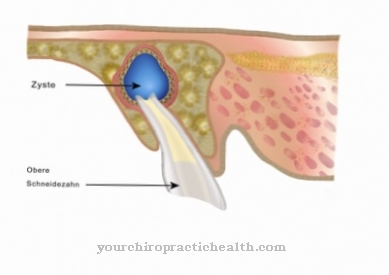Contrasting with the rest of the skin color Pigment spots, which are usually also referred to as birthmarks or, because of their dark color, as moles, are not only a cosmetic impairment for many people. Pigment spots can also be clear indications of a serious skin disease.
What are pigment spots?

The changes in the skin known colloquially as pigment spots are referred to in medicine as hyperpigmentation of the skin or chloasma. These irregularities are visually visible and partly palpable and differ in color from the surrounding skin areas.
As a rule, the pigment spots have a light or dark brown, reddish or ocher-colored surface. Basically, these spots are characterized by the fact that they are not raised, i.e. they are not visually higher than the surrounding skin regions.
Another name, which represents the term melasma, is also correct. The typical characteristics of both over-pigmentation are characterized by the fact that melanin is deposited in a stronger intensity in certain skin positions.
causes
The causes of pigment spots lie both in the internal disposition and in the influence of various external factors. In addition to hormonal changes in women during pregnancy and breastfeeding, as well as due to the birth control pill, more pigment spots can appear.
Other triggers for pigment spots are some medications and the previous disease of liver cirrhosis. In this context, hyper- or over-pigmentation occurs as a secondary disease. External influences that have a direct impact on the surface of the skin and contribute to the development of pigment spots are odorous substances such as sprays or perfumes, plant extracts in creams and intense sunlight.
In addition, the genetic constellations can also be responsible for the formation of the pigment spots.
Diseases with this symptom
- Age spots
- Shingles
- White spot disease
- Hyperpigmentation
- acne
- syphilis
- Cirrhosis of the liver
- psoriasis
- Skin cancer
course
A shift in the normally homogeneous distribution of melanin in the skin plays a fundamental role in the development of the melanin accumulations, which lead to the localized discoloration of the skin as pigment spots.
Some pigment spots, which are also known as pigment nevi, have already formed shortly after birth. During their formation, there is an increase in abnormal skin cells, which are actually made up of healthy melanocytes. As these melanocytes, which are responsible for normal skin color, increase in size, small or large pigment spots form over time.
Depending on the type of pigment spots and the cell growth, the liver spots can sometimes be raised, i.e. felt above healthy skin level.
Complications
In the majority of cases, pigment spots represent a purely aesthetic problem for the patient, but not a health problem. The pigment or age spots are mainly caused by the exposure of the skin to sunlight in the course of life. However, they have little in common with malignant moles.
For this reason, there are usually no complications to fear if pigment spots remain untreated. It is possible that the pigment spots increase, enlarge or darken with increasing age. However, this represents a purely cosmetic blemish without any disease value. If patients decide to have their pigment spots removed by a doctor for aesthetic reasons, various complications are possible.
Often a dermatologist removes the pigment spots using laser technology. The radiation burdens and irritates the skin considerably, which is why intense sun should be avoided for several weeks before and after the treatment. Otherwise there is a risk of renewed pigment formation, some of which are stronger and darker than the original pigment spots.
There is also the risk of blotchy spots on the skin or uneven pigmentation. After laser therapy, the skin is also extremely susceptible to infections, so that more thorough personal hygiene must be observed. Mechanical stress on the lasered pigment spots can also lead to complications during healing.
When should you go to the doctor?
As a rule, pigment spots do not need to be treated by a doctor. It is a harmless symptom that many people can experience. The pigment spots can increase, especially in the summer months or in times of high exposure to sunlight. However, no special treatment is necessary here either.
However, the person affected must apply enough sun protection and should generally not stay in direct sun for long. This can prevent the pigment spots from spreading or intensifying. The patient must also be careful not to mistake the pigment spots for a birthmark. Should the spots change, it is advisable to consult a doctor. A benign tumor can be removed. The change can be made either in shape, size or color. It is advisable to always watch pigment spots and birthmarks and to consult a doctor if there are any changes.
If the patient is dissatisfied with his appearance due to the pigment spots, these can be treated dermatologically. For this purpose, either cosmetic care products can be used or a treatment can be carried out by a doctor.
Doctors & therapists in your area
Treatment & Therapy
Basically it is possible to treat pigment spots. In this context, carefully selected medical methods are available. These are widely used in both dermatology and aesthetic medicine. As a rule, not only individual treatment elements are required, but a whole complex of several medical measures.
First of all, it is important to use an intensely acting UV blocker to protect the skin marked by pigment spots from normal solar radiation. The light protection must therefore be extremely high. A further variant of the treatment is a therapy for pigment spots, which is carried out with external substances.
Special chemicals like hydroquinone, glycolic acid and other drugs are effective in this context. If, despite these treatments, no improvements are achieved, a special peeling can be carried out in order to lighten the color of the upper layers of the pigment spots.
More extensive interventions against pigment spots are the method of cryotherapy in the form of freezing the birthmarks, the so-called microdermabrasion or surgical removal. The modern use of medical laser technology is also one of the non-surgical options for treating pigment spots.
Outlook & forecast
Pigment spots are not a serious medical problem that must be addressed. They are a common symptom for many people and therefore do not need to be removed.
In many cases, however, the pigment spots make the patient uncomfortable. This malaise can lead to stress or even depression, if those affected feel very uncomfortable with the unusual skin appearance. On the other hand, they can confidently put aside this self-perceived discomfort with a clear conscience. If the pigment spots cause psychological stress, a psychologist should be consulted. Often the psychological problems can be solved relatively easily.
Medical treatment does not take place. However, pigment spots can be covered relatively well by make-up articles if they are undesirable for the person concerned.
If there are pigment spots in particularly annoying areas, these can also be removed with the help of a laser. This treatment is not dangerous and does not lead to any other complications. However, after the pigment spots have been removed, a white area appears that does not heal any further. Scars do not form. Scrubs and other cosmetic products usually do not help.
People who find their pigment spots annoying should also enjoy UV radiation with great care, as this can lead to further pigment spots.
prevention
A prophylaxis against the development of the pigment spots is possible. This is particularly useful if pigment spots already appear on some parts of the body, although the causes are not immediately known. Since it is mainly women who suffer from pigment spots, protection from UV light, sun creams with a sun protection factor of at least 30 to 50 and medicinal creams are required.
The active ingredient carotaben, which can be bought in the form of capsules, can also be recommended. Covering open skin areas such as the face, décolleté and arms is also useful as a prevention against pigment spots.
You can do that yourself
Pigment spots are a harmless symptom that usually does not need treatment. Therefore, there are no medical self-remedies against the pigment spots. However, they can be prevented by avoiding direct sunlight on the skin. In summer, the patient should always apply sunscreen over the entire area and apply it if necessary. This can reduce the formation of pigment spots. The sun protection factor should be at least 30.
Especially women who take a contraceptive pill should use a relatively high protection factor for sun creams. Visits to the solarium are to be avoided in any case, as they encourage the development of pigment spots. If the patient feels uncomfortable with the pigment spots, drugs from the drugstore can be used to cover the respective areas. Of course, this is only possible and advisable to a healthy extent. In the drugstore, you can also find tinting creams and lotions that even out the skin tone of the affected areas. These can be used especially in winter. There are peelings especially for the face against pigment spots and other impurities on the skin. In discussions with a dermatologist, further possibilities can be found to reduce the annoying pigment spots.
























.jpg)



